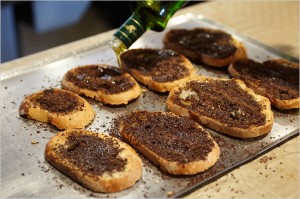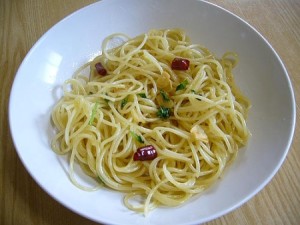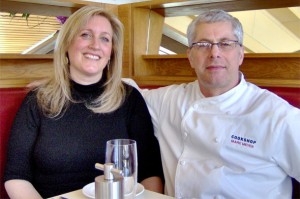HG likes to eat (and drink). And, when not indulging in these ever bright pleasures, HG likes to read about them. The most appetizing book about these subjects is Between Meals: An Appetite For Paris by A.J. Liebling, the New Yorker writer who had a prodigious appetite and a prodigious talent. He said of himself: “I write faster than anyone who writes better, and better than anyone who writes faster.” The book deals with Liebling’s culinary (and amorous life) in Paris. It’s witty, erudite and wonderfully evocative of that magical city. M.F.K Fisher is another writer who has written well of France, food, love and loss. Her prose is impeccable. Her recipes are terrible. Waverley Root has written definitive books about the food and wine of France and Italy. Nice analysis of tastes and regional specialties. Alexander Lobrano, Patricia Wells and blogger John Talbott are reliable reviewers of today’s Paris restaurants. Best of all New York restaurant reviewers was the late Seymour Britchky. Irreverent, funny and accurate. He died in 2004 and HG misses his acid reviews of pretentious restaurants. The New York Times, of course, has been the leader in restaurant reviewing. Craig Claiborne was the pioneer. Good judgment but much impressed by mediocre Chinese restaurants and Jewish delicatessens (probably due to a provincial Mississippi youth). Mimi Sheraton was HG’s favorite Times critic. Sheraton combined a love of “haimish” cooking with a taste for big, international flavors. HG also much enjoyed Ruth Reichl’s work at the Times before she moved on to Gourmet Magazine (sadly,no longer published). Current critic Pete Wells is at his best when he’s being destructive. Otherwise, he seems a bit too arch and precious. Sam Sifton, the food editor, is splendid. He’s made the Times a rich source of recipes and ideas for delicious home cooking (Melissa Clark is a standout. HG finds Mark Bittman uneven). Joseph Wechsberg, who wrote about European restaurants (and much else) for the New Yorker is ripe for rediscovery. And, HG recalls with fondness the down to earth midwestern flavored food writing of Clementine Paddleford (great name) of the long demised New York Herald Tribune. Calvin Trillin is the poet laureate of barbecue and other indigenous American foods (however, HG can never understand his love for the vastly overrated Mosca’s Restaurant near New Orleans). Jane and Michael Stern’s books about highway and roadside restaurants were lively and wildly influential but their selections are very uneven. They liked some terrible Tex-Mex and hamburger joints in Colorado but led HG/BSK to some very good eating in Montana and Washington. So, take their recommendations with caution.
Appetizing Writers
September 28th, 2015 § 2 comments § permalink
Aglio E Olio
April 27th, 2015 § 2 comments § permalink
Aglio e olio, Garlic and oil. Two noble ingredients. Spaghetti aglio e olio is the favored late night dish of Romans following alcoholic carousing in bars and clubs. It is the ultimate bachelor meal — made to eat out the of the pan, over a sink, steaming in a plate while hunched over a book when wife and children are out of the house. HG loves it for lunch, dinner or anytime but breakfast. Like all simple dishes, the best ingredients are key. The garlic should be fresh. The olive oil should be superior (Extra Virgin Sicilian olive oil is HG/BSK’s choice). There should be plenty of chopped (not too fine) Italian flat leaf parsley—some cooked with the oil and garlic and some scattered over the completed dish for aroma and visual decoration. Red chile pepper flakes are essential. HG/BSK like to melt anchovy filets in the sauce for a slightly salty bite. BSK made the dish last night in true Roman style (following suggestions from Mark Bittman, The New York Times food writer). The pasta was linguine instead of spaghetti. BSK sliced a goodly quantity of garlic very thinly. Simmered the garlic, parsley, pepper flakes and anchovy filets in olive oil. (BSK made sure the garlic was cooked through but not browned or burned). BSK removed the pasta from the salted, boiling water before it was quite done and added it to the pan where the sauce was simmering. And, now came the Roman touch. BSK added some starchy pasta water to the pan and began mixing with swooping motions until the pasta was properly al dente and the sauce was the appropriate texture. Served it from the pan after a shower of chopped parsley. Followed it with green salad and cheese. The wine choice was Chianti. Once more, BSK created a perfect meal.
Bittman Attacks French Food
July 26th, 2014 § 0 comments § permalink
Mark Bittman, the seemingly omnipresent food writer, did a recent op-ed piece in The New York Times bewailing the state of restaurants in France and their reliance on food “cooked at a faraway factory.” He is quite harsh in his opinions concerning Paris restaurants (he has to research and eat at three in order to find one good one). Bittman exaggerates (slightly). Sure, there are bad restaurants in France (as in every country) where owners pay more attention to profit than dining pleasure. And, sure, Paris is no longer the dining capital of the world. New York has taken over that spot. In addition to world class dining experiences like Per Se, Bernardin, etc., mighty Noo Yawk has an almost limitless array of interesting ethnic restaurants ranging from the entire spectrum of Korean and Chinese restaurants in Flushing to Ghana taxi driver food on the Grand Concourse in The Bronx to Uzbekistan eateries in Rego Park. And, if you want to recapture the golden age of French cuisine replete with lush flowers, deft service and classic dishes, one can turn back the clock and empty one’s wallet at La Grenouille on Manhattan’s posh upper East side. And, then there’s Brooklyn with its astounding metamorphosis into the world’s center of hipness with a multitude of food experiences to match its style. But, Paris, though no longer the ultimate gourmand destination, still has much to offer. Super baguettes and Poilane bread. Very good oysters (and guys who know how to shuck them). The best cheese and butter (Bordier). Wine shops stocked with splendid affordable vintages. Cafes, for the most part, offer mediocre food but world class viewing of stylish women (of all ages, thankfully). Bittman has a point. It’s not easy to find restaurants where fresh food is prepared on the premises. HG’s advice: Consult Alec Lobrano’s Hungry for Paris guide and John Talbott’s website. In Paris, HG spends much time at museums and cinemas. When it comes to food, HG is downscale. Favorite hangout is the back room of La Cave des Abbesses, a Montmartre neighborhood wine shop. In this very bare bones place, HG likes to linger over a platter of cheese with a carafe of red wine. In season, there are oysters for one Euro a piece. HG manages to get down a dozen with ease. La Cave is a nice place to visit after listening to the street musicians (usually quite talented) on the Place des Abbesses. HG also likes the gritty Arab/African neighborhood of Montmartre for couscous and other Maghreb specialties. Jour et Nuit is a good place for a hearty meal with the locals. Big flavors. Tiny prices.
Cookbooks
July 20th, 2013 § 0 comments § permalink
Cookbooks make for pleasant reading and often better viewing (some cookbook photography is so lustfully shot that it is basically pornographic). They often have good cooking ideas and can serve as an active spur to the imagination. But, very few contain recipes that, when followed step-by-step, turn out right. Mark Bittman, the ubiquitous Bittman, is the great advocate of simplicity and a best-selling cookbook author. In HG’s opinion, Bittman’s recipes disappoint. They should be read as creative outlines to constructing a dish rather than precise instructions. The recipes in Saveur Magazine sure read good but make for unfortunate eating (SJ disagrees). HG relies on three cookbook authors: Mimi Sheraton (the former New York Times restaurant reviewer); the late Michael Field and Marcella Hazan, the woman who has had a powerful and positive impact on cooking Italian food in the home kitchen. Mimi Sheraton’s cookbook, From My Mother’s Kitchen, is an HG favorite. There is a strong emphasis on Jewish cooking (but not kosher—there are good recipes for clams, lobster and a ham-and-bean soup). The recipes are can’t miss and they emphasize simple things like matzo brei, blintzes, fish salads, pan broiled steaks and hamburgers, etc. Michael Field’s books feature precise recipes. Do exactly as he says and you have a winner dish. Always. Marcella Hazan is invaluable. However, it is necessary to adjust the quantities. She likes, in the Italian fashion, a lot of pasta and a little bit of sauce. A lot of Americans (including HG/BSK) like the reverse.
Nepotism? An Emphatic “No!”
September 17th, 2012 § 1 comment § permalink
Mark Bittman had a good article recently in the New York Times expressing his displeasure with expensive, elaborate meals at New York restaurants run by “celebrity” chefs. Unwelcoming atmosphere. Fussy food. A $200 price and you don’t have a good time. Antithetical to this are the three New York restaurants run by HG’s daughter, Victoria, and her chef/partner/husband Marc Meyer. The restaurants are Cookshop (Chelsea), Hundred Acres (Soho) and Five Points (Noho). Do not accuse HG of nepotism, favoritism or clouded judgment. In matters of cuisine (if nothing else) HG is the soul of honor, objectivity and probity. Victoria’s restaurants don’t need HG’s aid. They are busy, successful places with lots of steady customers and many famous faces among the diners. The food? Strictly locavore. Generous portions. Robust flavors. Affordable prices. Very good wines and splendid, beautifully shucked oysters. Brunch is a special treat. Check out the restaurant websites. You’ll get hungry. When you go, say HG sent you.
A Great Idea From Spain: Bread. Chocolate. Olive Oil. Sea Salt.
July 8th, 2011 § 0 comments § permalink
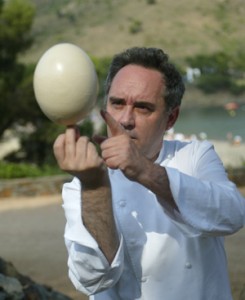 Ferran Adria, the owner/chef of El Bulli in Spain, is the most influential chef of his generation. He and his brother have single handedly reinvented the art of cooking and plating food by fusing the methods of science and the aesthetics of post-modern art with traditional culinary strategies.
Ferran Adria, the owner/chef of El Bulli in Spain, is the most influential chef of his generation. He and his brother have single handedly reinvented the art of cooking and plating food by fusing the methods of science and the aesthetics of post-modern art with traditional culinary strategies. 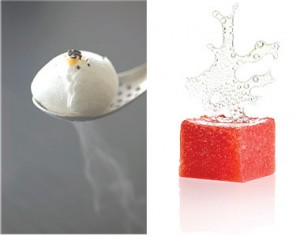 Simply put, Adria’s kitchens are more like laboratories where he experiments with deconstructing food into bubbles, foams, gossamer strands of taste, etc.. His “cook-books” are records of those experiments and are so lushly illustrated and painfully beautiful that they call out for placement on a coffee table far more than a spot in the kitchen. He has been called the father of “molecular gastronomy.” Food critics, other chefs and big time gourmets have raved and genuflected to his name.
Simply put, Adria’s kitchens are more like laboratories where he experiments with deconstructing food into bubbles, foams, gossamer strands of taste, etc.. His “cook-books” are records of those experiments and are so lushly illustrated and painfully beautiful that they call out for placement on a coffee table far more than a spot in the kitchen. He has been called the father of “molecular gastronomy.” Food critics, other chefs and big time gourmets have raved and genuflected to his name.
HG has had no desire to visit El Bulli (thankfully, since it is astronomically expensive). HG’s tastes are simple, rustic, ethnic. HG may be avant garde in his literary and political thinking, but at the table HG is a conservative (possibly a reactionary). In case you missed it, Mark Bittman did an article in the Sunday NY Times about Adria’s simple down home cooking for his restaurant staff.
One recipe, in particular, struck a chord with HG–Bread With Chocolate and Olive OIl. Here it is: Toast 6 slices of country bread in a 325 degree oven. Toast on both sides (it will take about 6 to 7 minutes). Grate 6 ounces of bittersweet chocolate (preferably 60% cocoa). Cover the toasts with the chocolate. Drizzle the with 1/4 cup olive. Sprinkle with coarse salt.
Now this HG approves of. Calls for a bottle of robust red, no?